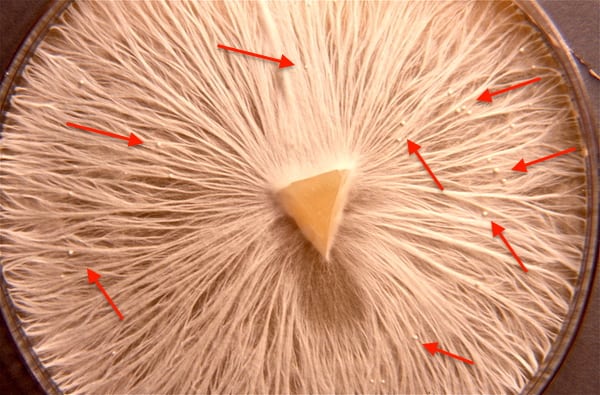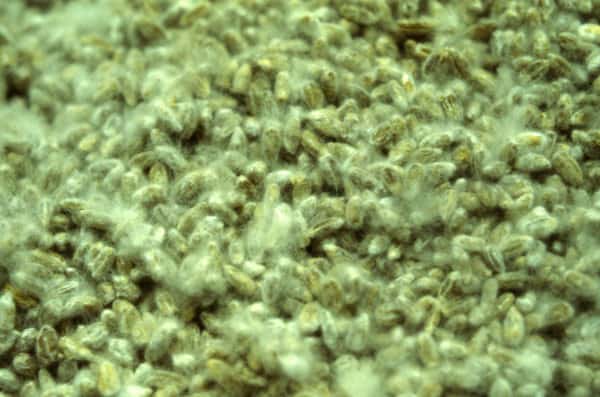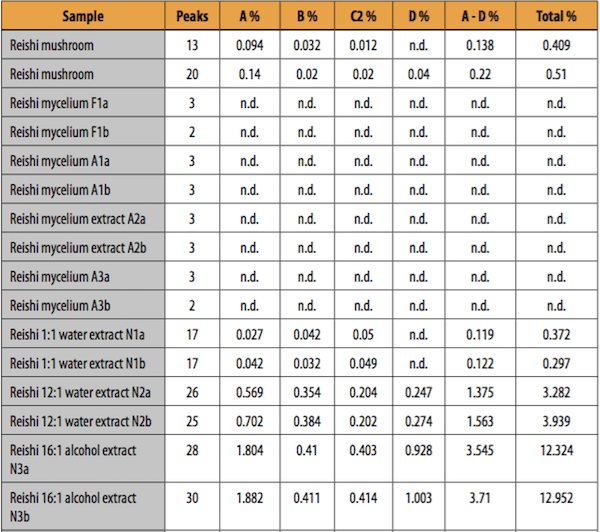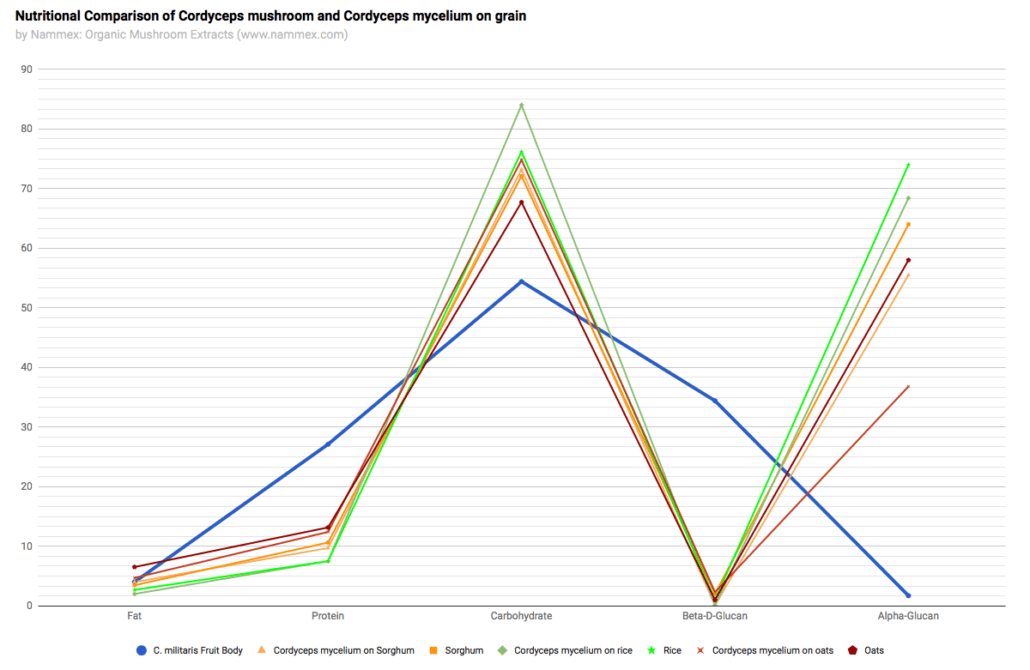When it comes to mushroom products, the term "Full Spectrum" gets used a lot.
It is an interesting statement, but what does it mean?
Is it simply a marketing gimmick?
An examination of this statement shows that U.S. producers of mycelium are primarily claiming that their product has all of the fungal parts: mycelium, mushroom, and spores.
In addition, they claim the presence of secondary metabolites and extra-cellular compounds that they maintain are secreted by the mycelium into the sterile grain which their mycelium grows on.
So they are proposing that their products contain a complete menu of what is important in a “medicinal mushroom” product.
An accurate definition of Full Spectrum would be a product that has the full complement or complete range of typical or possible elements, as in nutritional and medicinal compounds.
Let's break this down and see what it really looks like.
The Presence of Mycelium
There is definitely mycelium in these products but the question is, just how much?
U.S. producers of mycelium actually grow their mycelium on cooked, sterilized cereal grain (rice, oats, sorghum, etc). What they don’t talk about is that the grain is not separated from the final product so it is not 100% mycelium like often assumed, but a myceliated grain, very much like the food product called Tempeh.

How much of the final product is mycelium and how much is grain?
Nammex alpha-glucan testing has determined that U.S. grown mycelium on grain, what we refer to as MOG, is mostly starch from the residual grain. This was also confirmed in the McCleary & Draga paper (1).
Nammex ergosterol testing has shown that U.S. grown MOG has as little as one tenth the amount of ergosterol as actual mushrooms. Ergosterol is a fungal sterol and a key indicator of fungal matter. Testing for ergosterol is actually used by the grain industry to measure the amount of fungal contamination in stored grain.
Low ergosterol and low beta-glucans (see Active Compounds below), along with high alpha-glucans confirm that the amount of mycelium in MOG is minimal.
The Presence of Mushrooms
Since the ratio of mycelium, mushroom and spores is never given for a "full spectrum" MOG product, one must take their word that mushrooms are present.
Mushrooms contain very low levels of alpha-glucans in the form of glycogen. They do not contain starch.
Due to this, if a MOG product has any significant amount of mushrooms included, the levels of alpha-glucans should be lower and beta-glucan numbers should be higher.
So the amount of starch in a MOG product is directly proportional to missing fungal material. That is, if there is a high amount of grain starch in a MOG product then there must be a low amount of fungal material.
Mushroom vs Mycelium Fermented Grain. Beta-glucan analysis using the industry standard Megazyme test (Ver.08/23). Note that an AOAC starch analysis will give the similar results for alpha-glucans, verifying the accuracy for the Megazyme method.
Primordia are Not Mushrooms
The presence of mushrooms claim is often substantiated by claiming the presence of primordia growing on the mycelium colonized grain. Primordia are the initial aggregation of mycelia that precedes the actual mushroom stage. But primordia have not differentiated at this stage and are still just a small knot of mycelium.

As you can see, primordia are very tiny and would contribute very little to the overall quantity of a MOG product.
External Addition of Mushrooms
If mushrooms are added externally after the MOG is harvested then the distribution of each should be noted in separate line items in the Supplements Facts panel on the product label to give consumers accurate information with which to make informed purchasing decisions.
The Presence of Spores
If a product contains spores, it must first have the mushrooms that produce the spores. Without mushrooms, few spores, if any, will be present. Spores are not digestible or a proven active part of the fungal organism so their presence or lack of presence is not an important issue.
Whole spores have no proven medicinal value. This is why reishi spore products are "cracked" or "broken" prior to sale.
The Presence of Grain
What is often overlooked and unstated is the presence of grain in a MOG product. Nammex analysis of MOG products has shown alpha-glucan numbers from 30-60%. This is almost solely in the form of starch which comes from the residual grain which is not fully consumed by the mycelium.

Can a mushroom product be a complete representation of these fungal organisms if it contains 30-60% starch?
Analysis shows that MOG products contain a significant amount of residual grain and this has been measured as high levels of alpha-glucans in the form of starch.
The Presence of Active Compounds
Mycelium on Grain has low levels of the important beta-glucans.
Beta-glucans make up the majority of the fungal cell wall and are responsible for the immunological activity of mushrooms. Nammex beta-glucan testing using the Megazyme test shows an average of 6% beta-glucans in MOG whereas mushrooms have an average of 35% beta-glucans.
If a MOG product has low amounts of beta-glucans this would indicate a lack of actual fungal material. It would also demonstrate a critical deficiency.
The Presence of Secondary Metabolites
Secondary metabolites are well known in mushrooms and produced in quantity.
Mycelium producers claim these metabolites are produced in their grain-grown products. But rather than providing analytical data as proof, instead they point to research with mycelium grown in liquid culture. Mycelium grown in liquid culture (ie. Cordyceps Cs-4) and mycelium grown on grain are completely different products.
[av_table purpose='tabular' pricing_table_design='avia_pricing_default' pricing_hidden_cells='' caption='Liquid culture mycelium vs mycelium grown on grain' responsive_styling='avia_responsive_table' av_uid='av-mkt9z7'] [av_row row_style='avia-heading-row' av_uid='av-kmy24z'][av_cell col_style='' av_uid='av-isfq5f'][/av_cell][av_cell col_style='' av_uid='av-hpiemb']Beta-Glucans[/av_cell][av_cell col_style='' av_uid='av-fkzzo3']Alpha-glucans[/av_cell][/av_row] [av_row row_style='' av_uid='av-e379g3'][av_cell col_style='' av_uid='av-ca50gj']Cordyceps Cs-4[/av_cell][av_cell col_style='' av_uid='av-12xu5v']7.58%[/av_cell][av_cell col_style='' av_uid='av-8xeqer']1.61%[/av_cell][/av_row] [av_row row_style='' av_uid='av-83fcdv'][av_cell col_style='' av_uid='av-5ohewz']Cordyceps mycelium grown on grain[/av_cell][av_cell col_style='' av_uid='av-3lysub']1.5%[/av_cell][av_cell col_style='' av_uid='av-2jnzhv']64%[/av_cell][/av_row] [/av_table]
As seen above, the difference in beta-glucans and alpha-glucans confirms the lack of mycelium in mycelium grown on grain and the high presence of starch. This also demonstrates that pure mycelium also has low levels of alpha-glucans.
Nammex analysis has shown high amounts of secondary metabolites such as triterpenoids in reishi mushrooms and next to no triterpenoids in MOG reishi products.

There is little to no research that demonstrates beneficial levels of secondary metabolites are being produced by mycelium grown on grain. In fact, the opposite has been shown.
The Not So Full Spectrum
It is clear that MOG products are not full spectrum in any true sense of the term. Despite claims, analysis shows that they lack fungal material which corresponds to lack of active compounds and high levels of grain starch.

It is seriously misleading for a Mushroom product to be called Full Spectrum if it contains 30-60% grain starch. That is not a true representation of these fungal organisms.
A genuine mushroom product has high levels of beta-glucans and low levels of alpha-glucans. It also has triterpenoids and ergosterol and a profile that conforms to the mushroom, not the grain.
This fact was confirmed in recent research by USP (United States Pharmacopeial Convention). They determined through a number of analytical methods that only 5 of 19 samples of reishi mushroom products could actually be considered genuine. Three of those 5 samples were extracts from Nammex. (2)
If you are looking for a truly beneficial mushroom product, it is the mushroom itself that has the full complement and complete range of nutritional and medicinal compounds. The mushroom, traditionally used for centuries and scientifically proven, is genuinely Full Spectrum.
References
- McCleary, B. V., & Draga, A. (2016). Measurement of Beta-Glucan in mushrooms and mycelial products. Journal of AOAC International, 99(2), 364–373.
- Wu, D.-T., Deng, Y., Chen, L.-X., Zhao, J., Bzhelyansky, A., & Li, S.-P. (2017). Evaluation on quality consistency of Ganoderma lucidum dietary supplements collected in the United States. Scientific Reports, (June), 1–10.

